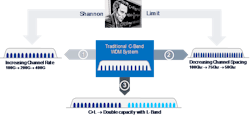With the ever-increasing demand for high-speed data, internet, and video services, carriers are faced with ongoing network upgrades to support higher transport capacities. The global COVID-19 pandemic and related work-from-home initiatives are causing tremendous increases in network capacity. Carriers have reported experiencing 30% – 50% bandwidth growth, which may have been typical growth for an entire year, now occurring in just a matter of weeks. Longer-term, capacity needs will continue to increase due to the shift to cloud-based software applications, 5G systems, and the coming fourth industrial revolution — or Industry 4.0.
Many regional and long-haul carriers operate their networks over leased fiber pairs (e.g., dark fiber), instead of physically owning the fiber cable. Traditionally, these carriers need to lease an expensive second pair of fibers and overlay new WDM systems once their existing C-Band WDM networks are filled. Unfortunately, leasing fibers over regional or long-haul 1000 – 3000 km routes can be prohibitively expensive, along with the cost and time needed to build overlay networks.
Carriers can benefit by deploying C+L-Band WDM systems to increase capacity on their existing optical network. Adding L-Band capacity to an existing network doubles the network capacity over their existing fiber pair, eliminating the need for a leased second pair of dark fibers.
Reaching C-Band Limits
Network operators have kept pace with ever-increasing bandwidth needs by utilizing higher-speed wavelengths and reduced channel spacing to successfully increase network capacity over the C-Band (Figure 1). Historically, carriers could add capacity to their network by simply deploying faster and faster wavelengths, initially from 10G to 100G wavelengths, and more recently from 100G to 200G to 400G wavelengths. Alternatively, carriers could add additional channels to the network by decreasing the channel spacing from 100 GHz to 50 GHz. These two options of increasing wavelength capacity and reducing channel spacing are interrelated and both constrained by the overall Shannon Limit on fiber capacity.
Modern fourth- and fifth-generation coherent DSPs offer multi-baud rates, multiple modulation formats, and strong forward error correction (FEC) to ensure optimized wavelength capacity at any reach — from metro to subsea distances. And, coherent-optimized colorless-directionless-contentionless-flexgrid (CDC-F) ROADMs can leverage the 200G-600G wavelength modes of these DSPs that require new channel spacings (e.g., 62.5 GHz, 75 GHz, 87.5 GHz, etc.). The advancements in coherent DSPs and optics have resulted in tremendous capacity improvements over the last 10 years while reducing the overall cost per gigabit. Unfortunately, with modern transponders operating so close to the Shannon capacity limit, future capacity and spectral efficiency improvements in the C-Band will be fairly limited.
How then does a carrier efficiently and cost-effectively expand their network capacity? By adding L-Band capacity to their C-Band networks, carriers can double their network capacity over their existing networks. The ability to double capacity on existing fiber with C+L-Band WDM systems is especially critical where carriers operate over leased dark fiber.
Flexible Upgrade Options
One key aspect of C+L-Band WDM systems is the efficiency and cost-effectiveness of the network upgrade. In other words, how easy is it to add the L-Band system to existing, deployed C-Band networks? Carriers have different operational and capex requirements, so supporting modular, flexible upgrade options ensures wide industry adoption — as opposed to the inevitable limitations of “one size fits all” approaches.
Many carriers have chosen to deploy their C-Band WDM systems per normal, standalone C-Band WDM procedures. Once the C-Band channels are filled, the L-Band equipment is added to the existing ROADM and in-line amplifier (ILA) sites. Since the L-Band equipment is only added when needed, there’s no expensive “initial cost” or stranded L-Band investment — it’s the ultimate “pay as you go” upgrade process, as shown in Figure 2, Option 1.
Alternatively, some carriers may prefer the option where ILA sites are installed as C+L ILA nodes from the initial deployment. Since backbone ILA nodes tend to be located at remote sites, installing C+L ILA nodes as part of the initial deployment saves time and operations cost, as the remote ILA sites do not have to be revisited during the L-Band upgrade. When additional L-Band capacity is needed, only the ROADM sites need to be upgraded with the additional L-Band equipment, as shown in Option 2. Since ROADM nodes are typically located in staffed central offices and data centers, the upgrades can be performed quickly and efficiently.
Understanding SRS Tilt Management
The decision to deploy C+L-Band WDM systems to maximize network capacity, efficiency, and cost per bit must consider any performance-limiting issues. One issue affecting WDM network performance is Stimulated Raman Scattering (SRS). SRS is a nonlinear effect in optical fibers that causes optical power to shift from shorter wavelengths to longer wavelengths, resulting in wavelength tilt across the spectrum. This effect is present in C-Band-only WDM systems, as shown in Figure 3, as well as C+L WDM.
Within a single C-Band, vendors manage SRS tilt by applying a pre-emphasis to the wavelengths at each amplifier site. The amplifiers monitor the power of every wavelength at each node and slightly adjust (increase) the shorter wavelength’s power to ensure a flat wavelength response. WDM systems automatically adjust SRS pre-emphasis as wavelengths are added or deleted from the network. This dynamic, self-tuning SRS tilt management ensures carriers never have to worry about SRS tilt.
On C+L networks, SRS tilt still occurs with the individual bands, as well as across C+L bands. Modern, state-of-the-art WDM systems incorporate control systems operating across both C- and L-Band systems, as shown in Figure 4, adjusting the tilt profile and per-channel wavelength powers in both C-Band amplifiers and L-Band amplifiers to ensure a flat wavelength spectrum across both bands. The amount of pre-emphasis tilt applied to each C- and L-Band is dynamically adjusted, depending on the wavelengths used within each band. These self-tuning WDM systems provide optimized SRS tilt and per-channel power management over both C+L networks, without any carrier intervention or adjustment — automatic and worry-free.
An alternative method to dynamic SRS tilt management over C+L bands requires “noise loading” of unused channels. Noise loading is a technique used in subsea systems, where unused optical channels are loaded with artificial optical noise power, sometimes referred to as “dummy light.” Noise loading in subsea networks is required due to the type of amplifiers (constant power) used in subsea systems. When applied to terrestrial networks, noise loading effectively operates the WDM line system as if it were completely filled.
Even with noise-loaded systems, SRS tilt pre-emphasis is still required on both C-Band-only systems as well as C+L WDM networks, but it is not dynamically adjusted as wavelengths are added or deleted to the network. Noise-loaded systems result in slightly higher “upfront costs,” as both C-Band noise-loading modules and L-Band noise-loading modules have to be incorporated into the WDM system with the initial deployment. Also, under fault scenarios where a noise-loading module fails, the system still needs to perform “dynamic” SRS tilt adjustment to prevent service degradation.
Benefits of C+L Networks
The improvement in optics and coherent DSP technology over the last 10 years has resulted in a tremendous increase in network capacity, while at the same time dramatically reducing the cost per gigabit for optical networks. As our optical networking industry approaches Shannon fiber capacity limits, future bandwidth and spectral efficiency improvements will be more limited.
By deploying C+L-Band WDM systems, carriers can double their capacity over their existing networks, which is ideal for regional and long-haul carriers operating over dark fiber. C+L-Band WDM systems eliminate the need for additional, costly dark fiber leases. Modular and flexible C+L-Band WDM systems ensure carriers can upgrade their networks most efficiently and cost-effectively. While SRS is a very real nonlinear effect, automated self-tuning systems with SRS tilt management that can operate over both C+L bands are key to enabling worry-free optical network operations.
Randy Eisenach is part of the WDM and High Speed Optics Product Management team at Nokia. He specializes in optical transport technologies, next-generation ROADM architectures, and high speed photonics.
Dave Brown is a senior manager of optical networking product marketing at Nokia. Dave’s experience includes product management and marketing roles in integrated circuit, electronic manufacturing services, and optical networking systems companies. He is director of communications and immediate past president of the Optical Internetworking Forum (OIF).




